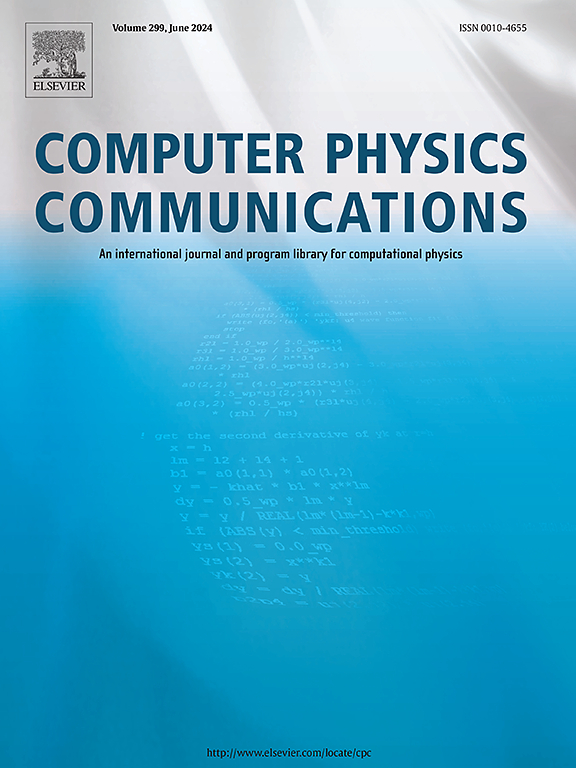三维弯曲薄膜物理模拟的保形方法
IF 3.4
2区 物理与天体物理
Q1 COMPUTER SCIENCE, INTERDISCIPLINARY APPLICATIONS
引用次数: 0
摘要
三维纳米结构广泛应用于物理学的各个领域,包括自旋电子学、光子学和超导学。在这方面,弯曲的薄3D膜在纳米和光电子学、传感器和信息处理方面的应用尤其有趣,这使得复杂3D几何形状的物理模拟对于揭示新的物理现象和开发设备是必不可少的。在这里,我们提出了一种通用的方法来进行薄弯曲3D膜的物理模拟,该方法允许使用有限差分方法而不是无网格方法或不规则网格方法进行模拟。该方法利用初始曲面到平面域的数值共形映射,并基于均匀化定理,该定理表明任何单连通黎曼曲面的共形等价于开单位盘、复平面或黎曼球。我们揭示了许多涉及拉普拉斯算子和散度的物理问题,初始问题的平面域公式只需要通过包括保形因子和平均/高斯曲率来修改运动方程和边界条件。我们展示了该方法在三维几何(包括c形和环状结构)的静电和磁场中的带电粒子Schrödinger方程的案例研究能力,以及时间相关的金兹堡-朗道方程。本文章由计算机程序翻译,如有差异,请以英文原文为准。
Conformal approach to physics simulations for thin curved 3D membranes
Three-dimensional nanoarchitectures are widely used across various areas of physics, including spintronics, photonics, and superconductivity. In this regard, thin curved 3D membranes are especially interesting for applications in nano- and optoelectronics, sensorics, and information processing, making physics simulations in complex 3D geometries indispensable for unveiling new physical phenomena and the development of devices. Here, we present a general-purpose approach to physics simulations for thin curved 3D membranes, that allows for performing simulations using finite difference methods instead of meshless methods or methods with irregular meshes. The approach utilizes a numerical conformal mapping of the initial surface to a flat domain and is based on the uniformization theorem stating that any simply-connected Riemann surface is conformally equivalent to an open unit disk, a complex plane, or a Riemann sphere. We reveal that for many physical problems involving the Laplace operator and divergence, a flat-domain formulation of the initial problem only requires a modification of the equations of motion and the boundary conditions by including a conformal factor and the mean/Gaussian curvatures. We demonstrate the method's capabilities for case studies of the Schrödinger equation for a charged particle in static electric and magnetic fields for 3D geometries, including C-shaped and ring-shaped structures, as well as for the time-dependent Ginzburg-Landau equation.
求助全文
通过发布文献求助,成功后即可免费获取论文全文。
去求助
来源期刊

Computer Physics Communications
物理-计算机:跨学科应用
CiteScore
12.10
自引率
3.20%
发文量
287
审稿时长
5.3 months
期刊介绍:
The focus of CPC is on contemporary computational methods and techniques and their implementation, the effectiveness of which will normally be evidenced by the author(s) within the context of a substantive problem in physics. Within this setting CPC publishes two types of paper.
Computer Programs in Physics (CPiP)
These papers describe significant computer programs to be archived in the CPC Program Library which is held in the Mendeley Data repository. The submitted software must be covered by an approved open source licence. Papers and associated computer programs that address a problem of contemporary interest in physics that cannot be solved by current software are particularly encouraged.
Computational Physics Papers (CP)
These are research papers in, but are not limited to, the following themes across computational physics and related disciplines.
mathematical and numerical methods and algorithms;
computational models including those associated with the design, control and analysis of experiments; and
algebraic computation.
Each will normally include software implementation and performance details. The software implementation should, ideally, be available via GitHub, Zenodo or an institutional repository.In addition, research papers on the impact of advanced computer architecture and special purpose computers on computing in the physical sciences and software topics related to, and of importance in, the physical sciences may be considered.
 求助内容:
求助内容: 应助结果提醒方式:
应助结果提醒方式:


